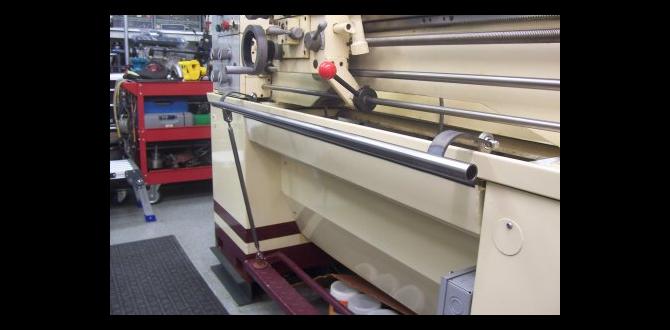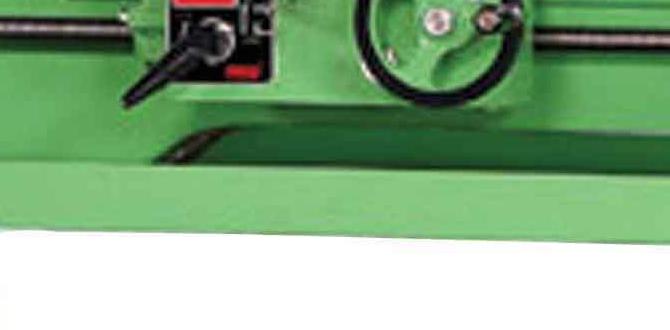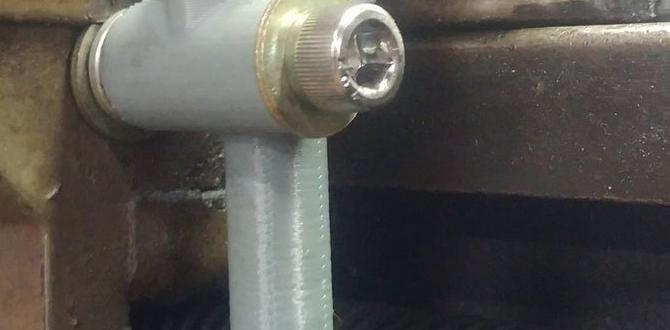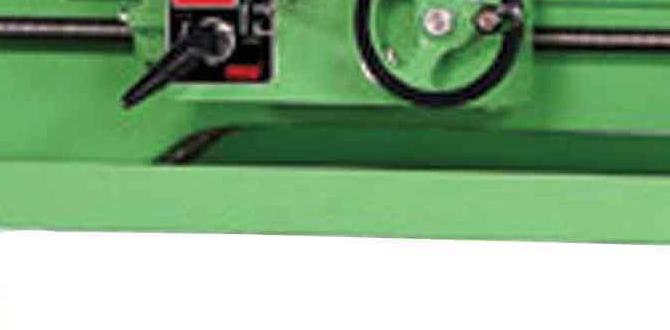Carbide end mills designed for D2 tool steel offer exceptional longevity and precision, making them a superior choice for machining this tough material effectively.
Hey everyone, Daniel Bates here from Lathe Hub! Have you ever tried cutting D2 tool steel and found your tools wearing down way too fast, leaving you frustrated? It’s a common challenge many of us face. D2 is a workhorse of a material, known for its hardness and wear resistance, but that also makes it tough on cutting tools. If you’re looking for a way to make your machining smoother, faster, and more cost-effective, you’re in the right place. Today, we’re diving deep into understanding why carbide end mills, especially those specifically made for D2, are your best bet. We’ll cover what makes them tick, how to choose the right one, and some tips to get the most out of them. Let’s get your D2 projects cutting like butter!
Why D2 Tool Steel Demands the Right End Mill
D2 tool steel is a fantastic material for a wide range of applications, thanks to its excellent combination of hardness, toughness, and wear resistance. Think industrial dies, punches, knives, and even some high-performance machinery parts. However, this very hardness is what makes it a real challenge to machine. Standard high-speed steel (HSS) end mills can quickly become dull, leading to poor surface finish, increased heat, and even tool breakage. This is where specialized cutting tools become not just a convenience, but a necessity.
When you’re working with D2, you’re essentially trying to cut through a material that’s designed to resist wear and deformation. This means your cutting tool experiences immense forces and heat. If your end mill isn’t up to the task, you’ll see:
- Rapid tool wear, leading to frequent replacements.
- Poor surface finish on your workpiece, requiring more post-machining work.
- Increased cutting temperatures, which can affect the material properties of your D2.
- Higher risk of tool chatter and breakage, posing safety hazards and costing you more in repairs and replacements.
To combat these issues, machinists have turned to advanced materials and designs that can withstand the rigors of cutting hardened steels like D2. Understanding the properties of D2 is the first step in appreciating why specific end mills are so crucial.
The Science Behind D2 Tool Steel
D2 is a high-carbon, high-chromium tool steel. The “D” in its name signifies its characteristic of being air-hardening. This means that when it’s heated and then cooled in air, it achieves significant hardness without the need for quenching in oil or water, which can sometimes lead to warping. Key components in D2 steel include:
- Carbon: Contributes to hardness and wear resistance.
- Chromium: Around 12%, it provides excellent corrosion resistance and helps in forming hard carbides, significantly boosting wear resistance.
- Molybdenum: Enhances hardenability and strength.
- Vanadium: Forms very hard carbides, further increasing wear resistance and red hardness (ability to retain hardness at elevated temperatures).
The presence of these hard carbides within the steel’s matrix is what makes D2 so durable. However, these carbides are also what make it abrasive and difficult to machine, essentially acting like tiny, hard particles that wear away at a cutting edge. This is precisely why using an end mill made of an equally or more resilient material is essential.
Enter the Carbide End Mill: A Superior Solution
Carbide, specifically tungsten carbide, is the material of choice for many demanding machining operations, especially when working with tough materials like D2 tool steel. It’s significantly harder and more rigid than high-speed steel. Here’s why carbide end mills are king for D2:
Carbide vs. HSS: The Key Differences
Let’s break down why carbide trumps HSS for this job:
- Hardness: Carbide is much harder than HSS at room temperature and, crucially, retains its hardness at higher temperatures (red hardness). This means it can cut effectively even when significant heat is generated.
- Rigidity: Carbide is stiffer than HSS. This rigidity helps in maintaining a precise cutting profile and reduces tool deflection, leading to better accuracy and surface finish.
- Wear Resistance: The extremely hard nature of carbide, combined with its ability to form wear-resistant coatings, gives it superior resistance to abrasion and chipping compared to HSS.
- Thermal Conductivity: Carbide generally has better thermal conductivity than HSS, meaning it can dissipate heat more effectively away from the cutting edge and into the chip, further reducing tool and workpiece temperature.
While carbide tools might have a higher initial cost than HSS, their extended tool life, ability to run at higher speeds and feeds, and the superior finish they provide often make them more economical in the long run, especially in production environments or for hobbyists tackling difficult materials.
Types of Carbide End Mills for D2
Not all carbide end mills are created equal. When targeting D2, you’ll want to consider these variations:
- 3-Flute vs. 4-Flute: For general machining of D2, 3-flute end mills are often preferred. They offer a good balance between chip evacuation (especially in slots) and rigidity. Four-flute mills provide better rigidity and surface finish but can struggle with chip evacuation in deeper pockets, which is a concern with tough materials generating a lot of chips.
- Coated vs. Uncoated: Coatings significantly enhance the performance of carbide end mills. For D2, coatings like TiAlN (Titanium Aluminum Nitride) or AlTiN (Aluminum Titanium Nitride) are highly recommended. These coatings add another layer of hardness, reduce friction, and improve heat resistance, drastically extending tool life.
- Square vs. Corner Radius: Square end mills are ideal for creating sharp 90-degree corners and general milling. Corner radius end mills have a rounded corner, which adds significant strength to the cutting edge, making it less prone to chipping, especially when plunging or encountering interrupted cuts. For D2, a corner radius can be a wise investment to bolster tool life.
The phrase “Proven D2 Tool Steel” in your search might refer to end mills specifically engineered with geometries and coatings optimized for this demanding alloy. These are designed to handle the high forces and abrasions encountered.
Choosing the Right Carbide End Mill for D2: Key Specifications
When you’re looking for that perfect end mill for D2, some specifications are more critical than others. Let’s break them down:
Diameter and Shank Size
This is straightforward: ensure the diameter matches your desired slot width or milling path. The shank diameter is also crucial for rigidity. For smaller diameters (e.g., 1/8 inch or 1/4 inch), a larger shank diameter relative to the flute length (if available) can add rigidity. For standard end mills, the shank is usually the same diameter as the cutting end, but variations exist (e.g., reduced shanks) for specific applications.
Flute Count
As discussed, 3 flutes are generally a great starting point for D2. They provide enough cutting edges for efficient material removal while ensuring good chip clearance. More flutes might be suitable for lighter finishing passes or materials that produce finer chips.
Length of Cut and Overall Length
Length of Cut: This is the portion of the end mill that has cutting edges. For D2, you generally want a balance. A shorter length of cut generally means a sturdier tool. However, if you need to mill deeper features, you’ll require a longer length of cut. Be mindful that as the length of cut increases, the tool becomes more susceptible to deflection and vibration, especially with smaller diameters. Always aim for the shortest practical length of cut for maximum rigidity.
Overall Length: This matters for tool holder clearance and reach. Ensure the end mill can be securely held in your collet or tool holder and still reach the depth required for your part without bottoming out the holder on the workpiece.
Coating
This is a big one for D2. Look for end mills with:
- TiAlN (Titanium Aluminum Nitride): Excellent for high-temperature applications, making it ideal for hard materials like D2. It forms a very hard, heat-resistant layer.
- AlTiN (Aluminum Titanium Nitride): Similar to TiAlN but can often withstand even higher temperatures, offering superior performance on very hard steels and in dry machining.
- Other advanced coatings: You might also find multi-layer ceramic coatings or diamond-like carbon (DLC) coatings designed for extreme wear resistance.
For D2, a TiAlN or AlTiN coating is a practically mandatory upgrade over an uncoated carbide end mill for achieving “long tool life.
Material and Geometry
- Carbide Grade: Micrograin or sub-micrograin carbides offer the best combination of hardness and toughness for machining aluminum and its alloys. For steels like D2, you want a carbide grade that emphasizes hardness and wear resistance. Manufacturers often use proprietary grades.
- End Mill Type: Standard, high-performance, or specific “D2” end mills. Look for those advertised for machining hardened steels.
- Corner Configuration: Square end, corner radius, or ball nose. As mentioned, a corner radius can significantly increase tool life on D2 by strengthening the cutting edge.
- Helix Angle: Standard helix angles (typically 30-45 degrees) are common. Higher helix angles can provide a sharper cutting action and better chip evacuation but can also increase the risk of chatter. For D2, a moderate helix angle is usually a good compromise.
What “Proven D2 Tool Steel” Might Really Mean
When you see “Carbide End Mill: Proven D2 Tool Steel,” it signifies that the end mill has been specifically designed, tested, and marketed with D2 and similar hardened steels in mind. This means it likely incorporates:
- A high-performance carbide grade.
- An advanced coating (like AlTiN or TiAlN).
- A geometry optimized for hardness and wear resistance (possibly with a small corner radius).
- Flute design that balances chip evacuation with rigidity.
These are not your general-purpose carbide end mills; they are specialists.
When to Use “Carbide End Mill 1/8 Inch 1/4 Shank Standard Length for Tool Steel D2 Long Tool Life”
This specific keyword phrase highlights several important aspects when targeting D2:
- Carbide End Mill: Confirms the material type, essential for hardness.
- 1/8 Inch: This refers to the diameter of the end mill. A 1/8 inch end mill is suitable for fine details, small slots, or for engraving. It’s a delicate size, so rigidity is paramount.
- 1/4 Shank: This refers to the diameter of the end mill’s shank. A 1/4 inch shank provides a good amount of rigidity for a 1/8 inch cutting diameter, helping to minimize deflection.
- Standard Length: This implies a typical length of cut and overall length, balancing reach with tool strength. Avoid excessively long end mills unless absolutely necessary.
- For Tool Steel D2: Explicitly states the intended application, meaning it’s designed to handle the challenges of D2.
- Long Tool Life: This is the “why” – the benefit you gain from using this specialized tool. It assures that the end mill is durable and cost-effective for machining D2.
So, if you need to machine fine features, plunge cut into D2, or create intricate details, a 1/8 inch carbide end mill with a 1/4 inch shank, featuring a robust coating and optimized geometry for long tool life, would be the precise tool for the job.
Essential Machining Parameters for D2 with Carbide End Mills
Using the right tool is only half the battle. Correct machining parameters are crucial for success. Machining D2 is typically done in its hardened state, which requires lower speeds and heavier feeds than machining softer materials. However, with modern carbide end mills, you can often achieve respectable cutting speeds.
These are general guidelines and can vary significantly based on your machine’s rigidity, the specific end mill geometry and coating, and the coolant you’re using. Always consult the end mill manufacturer’s recommendations if available.
Speeds and Feeds: The Balancing Act
Surface Speed (SFM or SMM): For hardened D2 (typically 58-62 HRC), you’ll likely be in the range of 150-300 SFM (45-90 SMM) with coated carbide end mills. Lower end for heavier cuts or less rigid setups, higher end for lighter cuts and rigid machines. For a 1/8 inch end mill, this translates to spindle speeds (RPM) calculated as:
RPM = (SFM 12) / Diameter (inches) or RPM = (SMM 1000) / (Diameter (mm) π)
Example:
For 200 SFM with a 1/8 inch (0.125″) end mill: RPM = (200 12) / 0.125 = 19,200 RPM. This is quite high, indicating the need for a high-speed spindle or potentially lower achievable SFM to bring the RPM into a manageable range for typical hobbyist machines.
Feed Rate (IPM or MMPM): This is critical for chip formation and heat dissipation. You want to produce a chip that carries heat away, not one that re-melts. For D2, feed rates will be lower than for mild steel. Aim for a chip load of around 0.0005″ to 0.001″ per flute for a 1/8 inch diameter end mill.
Feed Rate (IPM) = RPM Number of Flutes Chip Load per Flute
Example:
With 19,200 RPM, 3 flutes, and a chip load of 0.0008″: Feed Rate = 19,200 3 0.0008 = 46 IPM.
Always start conservatively and listen to the machine. If you hear chattering or see the surface finish degrading, adjust your parameters.
Depth of Cut and Stepover
Depth of Cut (DOC): This is how deep the end mill cuts into the material on each pass. For hardened D2, you need to keep the DOC relatively small, typically 0.020″ to 0.050″ (0.5mm to 1.2mm) for a 1/8 inch end mill, or even less depending on the machine rigidity. Full slotting (cutting a slot to the full diameter of the end mill) is generally discouraged with smaller end mills in hard materials.
Stepover: This is the amount the end mill moves sideways for each pass when milling a larger area. For D2, a stepover of 25-50% of the tool diameter is common. For trochoidal milling (a high-speed machining technique that uses a small stepover and high axial depth of cut in a circular path), you can achieve much higher material removal rates even in hard metals.
Coolant and Lubrication
Machining D2 generates a lot of heat. Proper cooling and lubrication are vital to:
- Prevent the cutting edge from overheating and losing its hardness.
- Reduce friction between the tool and workpiece.
- Flush chips away from the cutting zone.
- Improve surface finish.
For D2, flood coolant or a good quality cutting fluid specifically designed for steel is highly recommended. If flood coolant isn’t an option, consider a mist coolant system or even high-pressure air to help clear chips and keep temperatures down. Never machine D2 dry with carbide end mills.
Best Practices for Machining D2 with Carbide End Mills
Beyond choosing the right tool and setting parameters, a few key practices will ensure your success and maximize tool life.
Rigidity is Paramount
A rigid setup is non-negotiable when machining D2. This means:
- Using the shortest possible tool stick-out (length of end mill protruding from the tool holder).
- Ensuring your workpiece is firmly clamped to prevent any movement.
- Using a high-quality tool holder (e.g., a well-balanced collet chuck or side-lock holder).
- Making sure your machine’s ways and spindle are in good condition.
Any looseness or flex in your setup will be amplified when cutting D2, leading to chatter, poor finish, and premature tool wear.
Workpiece Holding
Your D2 part needs to be held securely. Use robust clamps, vises, or fixtures that can withstand the cutting forces without shifting. For small parts, consider using a vise with hardened jaws or a dedicated fixturing system. If you’re milling a thin part, adding support or using a sacrificial backing plate can





